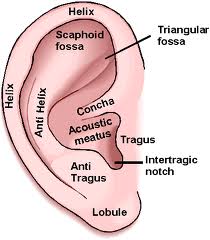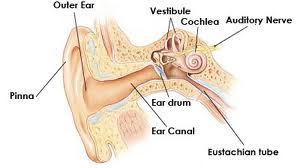|
Let's Start With The Outer Ear........
ComponentsThe outer ear has two important functions. The first and best known, is hearing. This involves the Auditory System which divides into three parts: The External Ear, The Middle Ear (Eardrum), and the Inner Ear. The second function concerns balance and equilibrium. The Vestibular System influences our eye movement and body positioning as we change our movements in space. Except for the outer Ear, the structures of the ear are within the temporal bone of the skull. The Human EarWhen most people think about the human ear, they visualize the fleshy part that protrudes from a person’s head.This part, the auricle or pinna, is only part of the ear. Most of the ear’s delicate, complicated mechanism lies hidden in deep cavities in the skull. The curves and convolutions of the pinna collect and funnel acoustic energy (sound) into the ear canal, which travels through the eardrum.Normally both ears work together to locate the original sound source, the direction of the sound, and separate one sound from another. The pinna consists of cartilage, covered with skin. There is a vast difference in the cartilage texture from person to person.
The blood vessels in the pinna are not plentiful and do not have much of a protective layer of fat. It is easy for the pinna to become frostbitten in extremely cold weather. The Ear CanalThe external auditory meatus or ear canal is not usually straight. It curves like a figure”S” lying on its side. In adults, it rises slightly upward, then slightly forward and downward toward the eardrum. The outer portion of the canal contains tiny hair cells (cilia) wax producing ceruminous glands and sebaceous (oil) glands. Here, a thick skin covers cartilage, while the inner portion has a thinner skin that lines temporal bone. The canal is normally a self-cleaning mechanism. The skin grows outward from the eardrum to the outer canal. The EardrumThe eardrum called the tympanic membrane or tympanum or drumhead, is the dividing line between the outer and middle ear.It is oval in shape, slightly convex, like a cone with the hollow part of the cone facing outward, and at a 30 degree angle to the bottom of the canal. Normal color is translucent, pearly white to pinkish grey. You can usually see through it. In children, the eardrum is thin and elastic, becoming thicker and more rigid in adults. The annulus or annular ring holds the eardrum in place, forming a watertight and airtight seal between the external and middle ear. Vibrations of sound, acoustic energy, enhanced by pinna and ear canal resonances, cause the eardrum to move back and forth in response to these vibrations. The eardrum is attached to the malleus in the middle ear.
|







